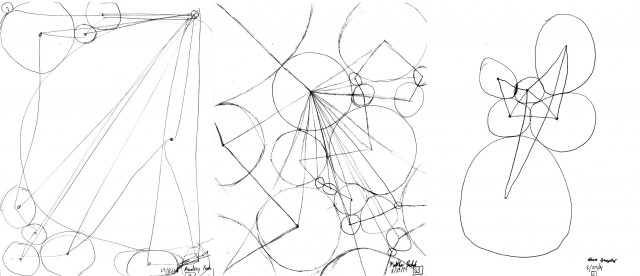Instructional Circles, Lines and more Circles
Here are the actual instructions provided to other students:
- Draw a small circle anywhere on the page, and draw a dot at the center of this circle.
- On any point on the circumference of this circle, draw a larger circle such that the circumference of this new circle is tangent to the circumference of the previous circle. Make sure that the new circle does not overlap with any other circles. Draw a dot at the center of this new circle.
- Repeat step 2 until not possible. Keep count of the number of circles drawn – the goal is to draw as many as circles as possible.
- Draw a line from the center of the last circle to the center of the previous circle.
- Repeat step 4 until the first circle is reached. (At the end, every line should be connected to at most 2 other lines.)
- Draw a line from the center of every circle drawn to the center of the very first circle drawn.
- On the bottom right of the page, sign your name, date, and also write down the total number of circles drawn. Draw a box around the total number of circles drawn.
Here are images of the results:
(From left to right: Audrey Yeoh’s interpretation, Matt Sebek’s interpretation, and Brent Strysko’s interpretation. Thank you all for being such excellent test subjects – er, art assistants.)
In retrospect, I think my instructions must have been rather confusing. Although I kindly informed my participants that I could not answer any queries about exactly what my instructions are asking them to do, every participant expressed a certain level of frustration regarding exactly what the end what supposed to look like. Although each acknowledged a certain lack of artistic ability (particularly when relating to drawing circles that are supposed to be more circular than blob-like), I was somewhat surprised at the difference in what I imagined the result to be and exactly what resulted. I understand that while my participants are not computers, it was somewhat interesting to see them execute the task considering each of them were from engineering backgrounds. Despite this, I was pleased by the level of randomness that occurred from unintended ambiguities from my instructions. If I were to do this again, I would attempt to gather people of different backgrounds and I would also add one more step at the beginning of my instructions: 0) Read all instructions before attempting to continue to step 1.
